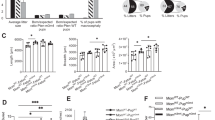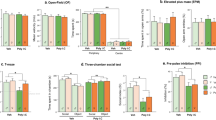Abstract
Approximately 40–50% of individuals affected by tuberous sclerosis (TSC) develop autism spectrum disorders (ASDs). One possible explanation for this partial penetrance is an interaction between TSC gene mutations and other risk factors such as gestational immune activation. In this study, we report the interactive effects of these two ASD risk factors in a mouse model of TSC. Combined, but not single, exposure had adverse effects on intrauterine survival. Additionally, provisional results suggest that these factors synergize to disrupt social approach behavior in adult mice. Moreover, studies in human populations are consistent with an interaction between high seasonal flu activity in late gestation and TSC mutations in ASD. Taken together, our studies raise the possibility of a gene × environment interaction between heterozygous TSC gene mutations and gestational immune activation in the pathogenesis of TSC-related ASD.
This is a preview of subscription content, access via your institution
Access options
Subscribe to this journal
Receive 12 print issues and online access
$259.00 per year
only $21.58 per issue
Buy this article
- Purchase on Springer Link
- Instant access to full article PDF
Prices may be subject to local taxes which are calculated during checkout




Similar content being viewed by others
References
Kelleher III RJ, Bear MF . The autistic neuron: troubled translation? Cell 2008; 135: 401–406.
Ehninger D, Silva AJ . Genetics and neuropsychiatric disorders: treatment during adulthood. Nat Med 2009; 15: 849–850.
Fombonne E . Epidemiological surveys of autism and other pervasive developmental disorders: an update. J Autism Dev Disord 2003; 33: 365–382.
Smalley SL . Autism and tuberous sclerosis. J Autism Dev Disord 1998; 28: 407–414.
Smalley SL, Tanguay PE, Smith M, Gutierrez G . Autism and tuberous sclerosis. J Autism Dev Disord 1992; 22: 339–355.
Campbell DB, Sutcliffe JS, Ebert PJ, Militerni R, Bravaccio C, Trillo S et al. A genetic variant that disrupts MET transcription is associated with autism. Proc Natl Acad Sci USA 2006; 103: 16834–16839.
Butler MG, Dasouki MJ, Zhou XP, Talebizadeh Z, Brown M, Takahashi TN et al. Subset of individuals with autism spectrum disorders and extreme macrocephaly associated with germline PTEN tumour suppressor gene mutations. J Med Genet 2005; 42: 318–321.
Williams PG, Hersh JH . Brief report: the association of neurofibromatosis type 1 and autism. J Autism Dev Disord 1998; 28: 567–571.
Zafeiriou DI, Ververi A, Vargiami E . Childhood autism and associated comorbidities. Brain Dev 2007; 29: 257–272.
Neves-Pereira M, Muller B, Massie D, Williams JH, O'Brien PC, Hughes A et al. Deregulation of EIF4E: a novel mechanism for autism. J Med Genet 2009; 46: 759–765.
Vanderklish PW, Edelman GM . Differential translation and fragile X syndrome. Genes Brain Behav 2005; 4: 360–384.
Sharma A, Hoeffer CA, Takayasu Y, Miyawaki T, McBride SM, Klann E et al. Dysregulation of mTOR signaling in fragile X syndrome. J Neurosci 2010; 30: 694–702.
Patterson PH . Immune involvement in schizophrenia and autism: etiology, pathology and animal models. Behav Brain Res 2009; 204: 313–321.
Chess S . Autism in children with congenital rubella. J Autism Child Schizophr 1971; 1: 33–47.
Chess S . Follow-up report on autism in congenital rubella. J Autism Child Schizophr 1977; 7: 69–81.
Chess S, Fernandez P, Korn S . Behavioral consequences of congenital rubella. J Pediatr 1978; 93: 699–703.
Libbey JE, Sweeten TL, McMahon WM, Fujinami RS . Autistic disorder and viral infections. J Neurovirol 2005; 11: 1–10.
Deykin EY, MacMahon B . Viral exposure and autism. Am J Epidemiol 1979; 109: 628–638.
Sweeten TL, Posey DJ, McDougle CJ . Brief report: autistic disorder in three children with cytomegalovirus infection. J Autism Dev Disord 2004; 34: 583–586.
Yamashita Y, Fujimoto C, Nakajima E, Isagai T, Matsuishi T . Possible association between congenital cytomegalovirus infection and autistic disorder. J Autism Dev Disord 2003; 33: 455–459.
Atladottir HO, Thorsen P, Ostergaard L, Schendel DE, Lemcke S, Abdallah M et al. Maternal infection requiring hospitalization during pregnancy and autism spectrum disorders. J Autism Dev Disord 2010 [e-pub ahead of print].
Ciaranello AL, Ciaranello RD . The neurobiology of infantile autism. Annu Rev Neurosci 1995; 18: 101–128.
Chez MG, Dowling T, Patel PB, Khanna P, Kominsky M . Elevation of tumor necrosis factor-alpha in cerebrospinal fluid of autistic children. Pediatr Neurol 2007; 36: 361–365.
Vargas DL, Nascimbene C, Krishnan C, Zimmerman AW, Pardo CA . Neuroglial activation and neuroinflammation in the brain of patients with autism. Ann Neurol 2005; 57: 67–81.
Nawa H, Takahashi M, Patterson PH . Cytokine and growth factor involvement in schizophrenia--support for the developmental model. Mol Psychiatry 2000; 5: 594–603.
Shi L, Tu N, Patterson PH . Maternal influenza infection is likely to alter fetal brain development indirectly: the virus is not detected in the fetus. Int J Dev Neurosci 2005; 23: 299–305.
Smith SE, Li J, Garbett K, Mirnics K, Patterson PH . Maternal immune activation alters fetal brain development through interleukin-6. J Neurosci 2007; 27: 10695–10702.
Zuckerman L, Weiner I . Post-pubertal emergence of disrupted latent inhibition following prenatal immune activation. Psychopharmacology (Berl) 2003; 169: 308–313.
Lee DF, Kuo HP, Chen CT, Hsu JM, Chou CK, Wei Y et al. IKK beta suppression of TSC1 links inflammation and tumor angiogenesis via the mTOR pathway. Cell 2007; 130: 440–455.
Colina R, Costa-Mattioli M, Dowling RJ, Jaramillo M, Tai LH, Breitbach CJ et al. Translational control of the innate immune response through IRF-7. Nature 2008; 452: 323–328.
Lorne E, Zhao X, Zmijewski JW, Liu G, Park YJ, Tsuruta Y et al. Participation of mammalian target of rapamycin complex 1 in Toll-like receptor 2- and 4-induced neutrophil activation and acute lung injury. Am J Respir Cell Mol Biol 2009; 41: 237–245.
Cao W, Manicassamy S, Tang H, Kasturi SP, Pirani A, Murthy N et al. Toll-like receptor-mediated induction of type I interferon in plasmacytoid dendritic cells requires the rapamycin-sensitive PI(3)K-mTOR-p70S6K pathway. Nat Immunol 2008; 9: 1157–1164.
Turnquist HR, Raimondi G, Zahorchak AF, Fischer RT, Wang Z, Thomson AW . Rapamycin-conditioned dendritic cells are poor stimulators of allogeneic CD4+ T cells, but enrich for antigen-specific Foxp3+ T regulatory cells and promote organ transplant tolerance. J Immunol 2007; 178: 7018–7031.
Onda H, Lueck A, Marks PW, Warren HB, Kwiatkowski DJ . Tsc2(+/−) mice develop tumors in multiple sites that express gelsolin and are influenced by genetic background. J Clin Invest 1999; 104: 687–695.
Moy SS, Nadler JJ, Perez A, Barbaro RP, Johns JM, Magnuson TR et al. Sociability and preference for social novelty in five inbred strains: an approach to assess autistic-like behavior in mice. Genes Brain Behav 2004; 3: 287–302.
Ehninger D, Han S, Shilyansky C, Zhou Y, Li W, Kwiatkowski DJ et al. Reversal of learning deficits in a Tsc2+/− mouse model of tuberous sclerosis. Nat Med 2008; 14: 843–848.
Reichenberg A, Gross R, Weiser M, Bresnahan M, Silverman J, Harlap S et al. Advancing paternal age and autism. Arch Gen Psychiatry 2006; 63: 1026–1032.
Moy SS, Nadler JJ, Magnuson TR, Crawley JN . Mouse models of autism spectrum disorders: the challenge for behavioral genetics. Am J Med Genet C Semin Med Genet 2006; 142: 40–51.
Wysocki CJ, Lepri JJ . Consequences of removing the vomeronasal organ. J Steroid Biochem Mol Biol 1991; 39: 661–669.
Di Cristofano A, Kotsi P, Peng YF, Cordon-Cardo C, Elkon KB, Pandolfi PP . Impaired Fas response and autoimmunity in Pten+/− mice. Science 1999; 285: 2122–2125.
Borlado LR, Redondo C, Alvarez B, Jimenez C, Criado LM, Flores J et al. Increased phosphoinositide 3-kinase activity induces a lymphoproliferative disorder and contributes to tumor generation in vivo. FASEB J 2000; 14: 895–903.
Xie C, Patel R, Wu T, Zhu J, Henry T, Bhaskarabhatla M et al. PI3K/AKT/mTOR hypersignaling in autoimmune lymphoproliferative disease engendered by the epistatic interplay of Sle1b and FASlpr. Int Immunol 2007; 19: 509–522.
Okada C, Akbar SM, Horiike N, Onji M . Early development of primary biliary cirrhosis in female C57BL/6 mice because of poly I:C administration. Liver Int 2005; 25: 595–603.
Paronen J, Liu E, Moriyama H, Devendra D, Ide A, Taylor R et al. Genetic differentiation of poly I:C from B:9-23 peptide induced experimental autoimmune diabetes. J Autoimmun 2004; 22: 307–313.
Wen L, Peng J, Li Z, Wong FS . The effect of innate immunity on autoimmune diabetes and the expression of Toll-like receptors on pancreatic islets. J Immunol 2004; 172: 3173–3180.
Moriyama H, Wen L, Abiru N, Liu E, Yu L, Miao D et al. Induction and acceleration of insulitis/diabetes in mice with a viral mimic (polyinosinic-polycytidylic acid) and an insulin self-peptide. Proc Natl Acad Sci USA 2002; 99: 5539–5544.
Haidinger M, Hecking M, Weichhart T, Poglitsch M, Enkner W, Vonbank K et al. Sirolimus in renal transplant recipients with tuberous sclerosis complex: clinical effectiveness and implications for innate immunity. Transpl Int 2010; 23: 777–785.
Maldonado M, Baybis M, Newman D, Kolson DL, Chen W, McKhann II G et al. Expression of ICAM-1, TNF-alpha, NF kappa B, and MAP kinase in tubers of the tuberous sclerosis complex. Neurobiol Dis 2003; 14: 279–290.
Lee LC, Newschaffer CJ, Lessler JT, Lee BK, Shah R, Zimmerman AW . Variation in season of birth in singleton and multiple births concordant for autism spectrum disorders. Paediatr Perinat Epidemiol 2008; 22: 172–179.
Atladottir HO, Parner ET, Schendel D, Dalsgaard S, Thomsen PH, Thorsen P . Variation in incidence of neurodevelopmental disorders with season of birth. Epidemiology 2007; 18: 240–245.
Stevens MC, Fein DH, Waterhouse LH . Season of birth effects in autism. J Clin Exp Neuropsychol 2000; 22: 399–407.
Bolton P, Pickles A, Harrington R, Macdonald H, Rutter M . Season of birth: issues, approaches and findings for autism. J Child Psychol Psychiatry 1992; 33: 509–530.
Barak Y, Ring A, Sulkes J, Gabbay U, Elizur A . Season of birth and autistic disorder in Israel. Am J Psychiatry 1995; 152: 798–800.
Gillberg C . Do children with autism have March birthdays? Acta Psychiatr Scand 1990; 82: 152–156.
Landau EC, Cicchetti DV, Klin A, Volkmar FR . Season of birth in autism: a fiction revisited. J Autism Dev Disord 1999; 29: 385–393.
Acknowledgements
We thank Paul H Patterson and Steven E Smith for valuable input regarding the gestational immune activation paradigm. This work was supported by funds of the German Center for Neurodegenerative Diseases to DE, the NIH R01 MH084315 to AJS and a grant from the Children's Hospital Boston Translational Research Program to MS.
Author information
Authors and Affiliations
Corresponding authors
Ethics declarations
Competing interests
The authors declare no conflict of interest.
Additional information
Supplementary Information accompanies the paper on the Molecular Psychiatry website
Supplementary information
Rights and permissions
About this article
Cite this article
Ehninger, D., Sano, Y., de Vries, P. et al. Gestational immune activation and Tsc2 haploinsufficiency cooperate to disrupt fetal survival and may perturb social behavior in adult mice. Mol Psychiatry 17, 62–70 (2012). https://doi.org/10.1038/mp.2010.115
Received:
Revised:
Accepted:
Published:
Issue Date:
DOI: https://doi.org/10.1038/mp.2010.115
Keywords
This article is cited by
-
Severity of Autism Spectrum Disorder Symptoms Associated with de novo Variants and Pregnancy-Induced Hypertension
Journal of Autism and Developmental Disorders (2024)
-
Tsc2 mutation rather than Tsc1 mutation dominantly causes a social deficit in a mouse model of tuberous sclerosis complex
Human Genomics (2023)
-
Dysregulation of the Wnt/β-catenin signaling pathway via Rnf146 upregulation in a VPA-induced mouse model of autism spectrum disorder
Experimental & Molecular Medicine (2023)
-
The research landscape of tuberous sclerosis complex–associated neuropsychiatric disorders (TAND)—a comprehensive scoping review
Journal of Neurodevelopmental Disorders (2022)
-
Exploring the mechanisms underlying excitation/inhibition imbalance in human iPSC-derived models of ASD
Molecular Autism (2020)



